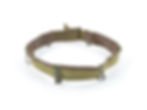The M1 Helmet Liner Headband: Manufacturers & Variations
- CIRCA1941
- Sep 11, 2020
- 3 min read
Updated: May 24, 2023
Unlike the M1917 and the later M1917A1, The American helmet of the second world war consisted of a two-piece design, an outer protective steel shell and an inner fiber liner. Both components were one-size-fits all. It was the removable headband which allowed for a specific fit to the wearer's head.

On April 28, 1941, Hawley Products Co. of St. Charles, Illinois received approval for its fiber helmet liner. Its design consisted of two rigid fiber shells cemented together, impregnated with water resistant chemicals, covered with olive drab fabric, and outfitted with a silver rayon suspension. The liner would then accept a small neckband and a headband, both of which were constructed of the same rayon material as the liner suspension.
The rayon headband's 12 snaps would fasten into the liner suspension's corresponding snaps. These snaps came in three different varieties: (1) nickel-plated brass, (2) blackened brass, and (3) a zinc finish.
Rayon headbands were not adjustable, instead they came in 13 different sizes.

The earliest rayon headbands' leather strip folded over to the side of the headband that was not in contact with the wearer's forehead.
This additional leather was eventually done away with on later examples as a cost-saving measure.
On the simplified headbands, the inked size stamping moved to the fold of the leather padding.

In addition to the size markings, rayon headbands will often feature manufacturer's markings, such as V_ for the Vogt Manufacturing Co., L_ for Lapeer Fabricators Inc., J for the Johnson & Johnson Co., and an unknown manufacturer, CG.



Six liner manufacturers (Hawley, General Fibre, St. Clair, M.S.A., Westinghouse, and Inland) utilized this rayon suspension in their liners until approximately late-1942, when the new cotton suspension was introduced. Two manufacturers (St. Clair and Inland) produced liners with transitional suspensions that continued to accommodate the 12-snap rayon headbands.
The 12 female snaps were eventually completely removed from the new cotton suspension and a new, adjustable headband was designed in order to replace the costly rayon headband, with its 13 different sizes.
The Scholl Manufacturing Co. designed the new cotton headband. It consisted of a strip of cotton twill, sewn onto which was a piece of leather.
The headband was secured to the liner's suspension via six "alligator" spring clips. Note in the photo below, the leather continues behind the spring clip. This would create uncomfortable "pressure points" on the wearer's head and eventually "cut-outs" in the leather would be made.
The new cotton headband could be adjusted to the wearer's head via a slider buckle, the earliest of which consisted of two pieces of steel wire, bent in the shape of a rectangle. These headbands are often referred to by collectors as "double wires".
The buckle system was simplified shortly after the introduction of the new headband. The new buckle consisted of a one-piece design, initially made of green-painted steel.
Even though liners with rayon suspensions were specifically designed to accommodate the rayon headband, it is quite common to encounter these earlier liners with later cotton headbands.
As the buckle evolved, so too did the spring clips. Below is the new type spring clip, with three jagged indentations at its sides and a straight bottom. Note the "cut-out", interrupting the leather.

The final version of the spring clip saw the introduction of a fold in the metal's bottom edge and an elimination of one set of jagged indentations at its sides.

Some headbands produced during the summer of 1942 exhibited a very uncommon variation, in which the leather fold was stitched behind the cotton fabric, as opposed to over the fabric.

Some of those summer 1942 headbands had an additional irregularity; the buckle was sometimes installed on the left end of the headband, where the strand of cotton fabric bearing the manufacturer's marking would normally be.

In an effort to save vital war material, the final iteration of the cotton headband saw the introduction of the blackened brass buckle. These headbands were produced from November 5, 1943 up until the war's end.
Out of concern for leather shortages, one unknown manufacturer began to experiment with a substitute material - vinyl. These vinyl headbands come in two different colors: black (sometimes appearing bluish) and brown. They all exhibit triple weave herringbone twill cotton and lack any manufacturer's markings. Whichever company produced them, they were likely a supplier to St. Clair and Hood Rubber, as these vinyl headbands often appear in liners produced by those two companies.
By war's end cotton headbands would come to bear the manufacturer's markings of 35 different producers. Unfortunately, sweat would often result in the fading of these markings, however the remaining photographs show all but one known producer - Harold Allen. If you have a Harold Allen headband, please feel free to contact us.


































If your liner is in need of an original headband, please view our regularly-updated selection of accessories.















